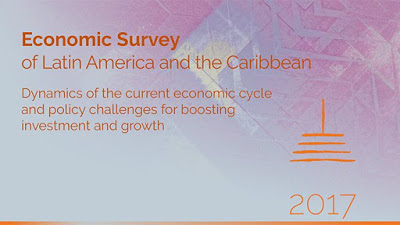Summary:
The Economic Commission for Latin America and the Caribbean´s (ECLAC) Economic Survey of Latin America and the Caribbean (“Dynamics of the current economic cycle and policy challenges for boosting investment and growth”) for 2016-2017 was published last Thursday (3 of August). It incorporates a number of heterodox concepts and ideas mainly in Part II. These include the notion of center and periphery (which provides the framework for Chapter III “The region’s current economic cycle and its various characteristics are partly a reflection of changes that have occurred in the international economy and in the way forces are transmitted from the more advanced to the developing economies.” p.117 ); the importance of the productive structure (Chapters III and IV) to analyze the impact of the
Topics:
Matias Vernengo considers the following as important: ECLAC, Latin America
This could be interesting, too:
The Economic Commission for Latin America and the Caribbean´s (ECLAC) Economic Survey of Latin America and the Caribbean (“Dynamics of the current economic cycle and policy challenges for boosting investment and growth”) for 2016-2017 was published last Thursday (3 of August). It incorporates a number of heterodox concepts and ideas mainly in Part II. These include the notion of center and periphery (which provides the framework for Chapter III “The region’s current economic cycle and its various characteristics are partly a reflection of changes that have occurred in the international economy and in the way forces are transmitted from the more advanced to the developing economies.” p.117 ); the importance of the productive structure (Chapters III and IV) to analyze the impact of the
Topics:
Matias Vernengo considers the following as important: ECLAC, Latin America
This could be interesting, too:
Matias Vernengo writes Maria da Conceição Tavares (1930-2024)
Matias Vernengo writes Is dependency over?
Matias Vernengo writes New book on the crisis of economics and teaching in Latin America
Chris Blattman writes The terrible trade-off: Why less violent cities often means more powerful and organized crime
The Economic Commission for Latin America and the Caribbean´s (ECLAC) Economic Survey of Latin America and the Caribbean (“Dynamics of the current economic cycle and policy challenges for boosting investment and growth”) for 2016-2017 was published last Thursday (3 of August). It incorporates a number of heterodox concepts and ideas mainly in Part II. These include the notion of center and periphery (which provides the framework for Chapter III “The region’s current economic cycle and its various characteristics are partly a reflection of changes that have occurred in the international economy and in the way forces are transmitted from the more advanced to the developing economies.” p.117 ); the importance of the productive structure (Chapters III and IV) to analyze the impact of the impulses from the center to the periphery; aggregate demand as a key driver of the world slowdown in trade (pp. 123-124); the relative importance of income versus substitution effects (pp.147-149); the investment multiplier (“There is ample evidence that points to the importance of protecting public investment …it represents a significant boost to economic growth in the medium term. …the cumulative effects of public spending variations on the output of 16 Latin American countries, with results showing that the cumulative multiplier of investment spending is significantly higher than that of consumption” p. 158); and the concept of total monetary demand (pp.163-166). As such the report represents a significant attempt to return to ECLAC´s Structuralist roots while at the same including some of the main ideas of other heterodox schools of thought (i.e., post-Keynesian).

